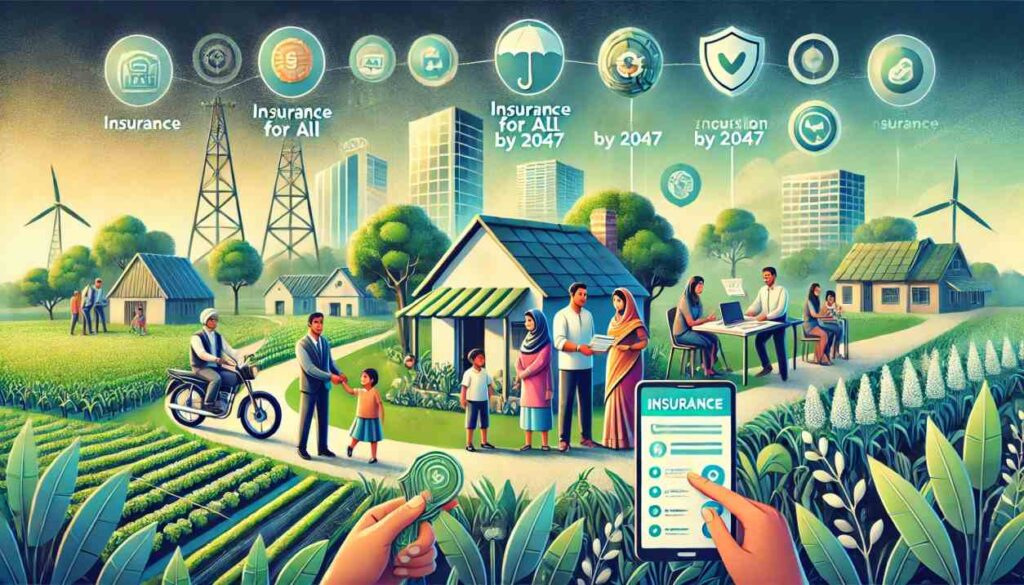
Introduction: A Step Toward Universal Insurance Coverage
India is on a mission to achieve ‘Insurance for All by 2047’, a transformative initiative aimed at ensuring that every household in the country has access to insurance coverage. BC Patnaik, the Director of the National Insurance Academy (NIA), emphasizes the critical role of research, innovation, and collaboration in driving this ambitious goal.
Despite notable progress in expanding insurance penetration, significant gaps remain in accessibility and adequacy of coverage. As the country celebrates its strides in insurance inclusion, policymakers, financial institutions, and researchers are working to address challenges and unlock opportunities for sustainable development.
Current State of Insurance Coverage in India
- Life Insurance:
- India has made remarkable progress in covering households under life insurance.
- 19 crore individual policyholders are covered by LIC, and 3.3 crore individuals are enrolled in PMJJBY.
- Approximately 76% of households now have access to at least one life insurance policy.
2. General Insurance:
- 54.4 crore beneficiaries are covered under Personal Accident insurance, and 45.9 crore individuals under PMSBY.
- 94.6% of the population above 14 years is estimated to have personal accident insurance.
3. Health Insurance:
- 57 crore individuals are covered under commercial health insurance, and 36.5 crore households are insured under Ayushman Bharat.
- Combined, 67% of the population is covered by health insurance schemes.
While these numbers are encouraging, under-insurance and lack of adequate coverage remain pressing concerns, particularly for low-income households.
Challenges to Achieving Insurance for All
Despite progress, the journey toward universal insurance coverage is hindered by several barriers:
1. Low Uptake of Microinsurance:
- Microfinance institutions (MFIs) often limit their insurance offerings to credit risk coverage, with limited adoption of other insurance products.
- Supply-side constraints such as high costs, operational challenges, and low professional skills among field personnel.
- Demand-side constraints including low awareness, lack of trust, and affordability issues in target populations.
2. Regulatory and Operational Issues:
- Complex regulations and high entry barriers for microinsurance institutions deter broader participation.
- Infrastructure gaps and logistical challenges limit outreach in rural and underserved areas.
3. Trust and Awareness:
- Lack of trust in financial institutions and limited awareness about the benefits of insurance products prevent many households from accessing coverage.
Opportunities and Strategies for Inclusive Insurance Growth
1. Role of Microfinance Institutions (MFIs):
- India has over 250 MFIs reaching 162 million households. These institutions have immense potential to drive insurance inclusion by offering microinsurance products beyond credit risk coverage.
- Recommendations from Dr. Archana Singh’s study highlight the need to address operational inefficiencies and improve training for MFI personnel.
2. Government and Regulator Initiatives:
- The Insurance Regulatory and Development Authority of India (IRDAI) has introduced initiatives like Bima Trinity and Bima Sakhi to enhance insurance penetration.
- A master circular issued in 2024 focuses on inclusivity in rural and social sectors and reducing entry barriers for microinsurance providers.
3. Technology and Innovation:
- Digital platforms and mobile technology can streamline the delivery of insurance products, reducing costs and improving accessibility.
- AI-powered solutions and data analytics can help insurers design personalized, affordable products tailored to the needs of underserved populations.
4. Focus on Sustainability and Resilience:
- Expanding climate and disaster risk insurance to protect vulnerable communities from environmental shocks.
- Leveraging ESG principles and green finance to align insurance initiatives with sustainable development goals.
International Comparisons: Room for Growth
India lags behind global averages in insurance penetration and density:
- Global Insurance Penetration: 7% vs. India’s 3.7%.
- Global Insurance Density: Rs 77,017 ($889) vs. India’s Rs 8,230 ($95).
- Comparatively, China’s insurance density is Rs 33,267 ($384), more than five times India’s.
To close this gap, India must focus on increasing awareness, affordability, and accessibility of insurance products.
Research and Knowledge Contribution
The National Insurance Academy (NIA) plays a pivotal role in advancing insurance inclusion through research and education:
- Dr. Archana Singh’s Work: Studies on microinsurance adoption by MFIs highlight the challenges and opportunities for expanding insurance coverage to underserved populations.
- Collaborative Research: The recently published book “Financial Markets, Climate Risk, and Renewables” explores the intersection of finance and sustainability, offering policy recommendations to achieve inclusive growth.
Looking Ahead: Insurance for All by 2047
Achieving the goal of ‘Insurance for All’ requires a concerted effort from all stakeholders, including:
- Policymakers simplifying regulations to promote inclusivity.
- Financial institutions leveraging digital and innovative solutions to improve outreach.
- Microfinance entities expanding their insurance offerings to cover diverse risks.
With a robust strategy and collaborative approach, India can unlock the potential of insurance inclusion, ensuring financial security and resilience for every household by 2047.


